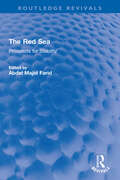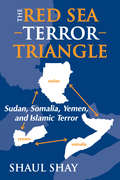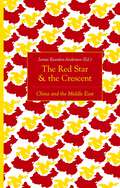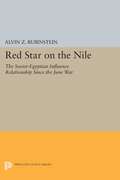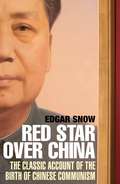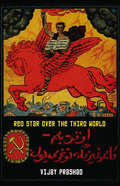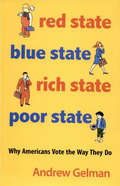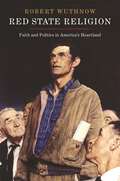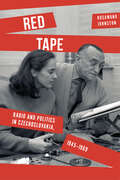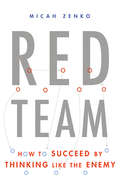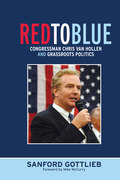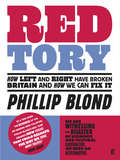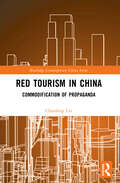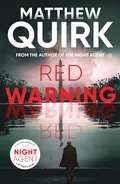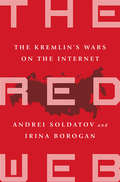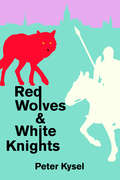- Table View
- List View
The Red Sea: Prospects for Stability (Routledge Revivals)
by Abdel Majid FaridFirst published in 1984, The Red Sea shines light on one of the world’s most important strategic waterways: Red Sea. A large proportion of Europe’s energy requirements are transported through the Red Sea, and provides a vital navigation for western military transport. It is also at the heart of an area of volatile regional conflict. This book reviews the economic, political and strategic prospects for the Red Sea and the countries which adjoin it. There is also discussion of the wider international implications of conflict in the Red Sea, in particular the strategic concerns of the United States and the erstwhile USSR. This book will be of interest to students of history, geography and international relations.
The Red Sea: Prospects for Stability (Routledge Revivals)
by Abdel Majid FaridFirst published in 1984, The Red Sea shines light on one of the world’s most important strategic waterways: Red Sea. A large proportion of Europe’s energy requirements are transported through the Red Sea, and provides a vital navigation for western military transport. It is also at the heart of an area of volatile regional conflict. This book reviews the economic, political and strategic prospects for the Red Sea and the countries which adjoin it. There is also discussion of the wider international implications of conflict in the Red Sea, in particular the strategic concerns of the United States and the erstwhile USSR. This book will be of interest to students of history, geography and international relations.
The Red Sea Terror Triangle: Sudan, Somalia, Yemen, and Islamic Terror
by Shaul ShayIn the aftermath of the terror campaign launched on Sep- tember 11, 2001, the United States declared war against global terror. It identified the al-Qaida organization and Afghanistan under the Taliban regime as the initial targets of the offensive, and Iraq as the next. However, aside from the countries included by President Bush in the Axis of Evil (Iraq, Iran, and North Korea), a triangle of countries in the Red Sea region are also potential targets in the war against terror - Sudan, Somalia, and Yemen.This assessment is based on the historical record: Each of these countries has in one form or another provided refuge for Islamic terror organizations. Sudan, Somalia, and Yemen are Muslim states, situated at the periphery of the heart of Islam, which is generally identified as the Arab Peninsula, Egypt, and the Fertile Crescent. This area is of strategic significance to both sides of the vital shipping route that connects the Arabian Sea (the Indian Ocean) and the Red Sea. Osama Bin Laden, al-Qaida, and members of other radical Islamic organizations have found allies and safe havens in both the heart of Islam and its periphery. The presence of radical Islamic entities in the region, alongside local problems and conflicts rooted in national, ethnic, and tribal issues, has turned the Red Sea countries into a nucleus of instability and dissension, one that threatens the security and peace of both neighboring and more distant countries.Shay examines the three countries designated as the Red Sea Terror Triangle, and explores the ties each maintains with Islamic terror, as well as the reciprocal links between them. Understanding these countries is of critical importance, since all or some of them may constitute a base for Islamic terror organizations in the future.
The Red Sea Terror Triangle: Sudan, Somalia, Yemen, and Islamic Terror
by Shaul ShayIn the aftermath of the terror campaign launched on Sep- tember 11, 2001, the United States declared war against global terror. It identified the al-Qaida organization and Afghanistan under the Taliban regime as the initial targets of the offensive, and Iraq as the next. However, aside from the countries included by President Bush in the Axis of Evil (Iraq, Iran, and North Korea), a triangle of countries in the Red Sea region are also potential targets in the war against terror - Sudan, Somalia, and Yemen.This assessment is based on the historical record: Each of these countries has in one form or another provided refuge for Islamic terror organizations. Sudan, Somalia, and Yemen are Muslim states, situated at the periphery of the heart of Islam, which is generally identified as the Arab Peninsula, Egypt, and the Fertile Crescent. This area is of strategic significance to both sides of the vital shipping route that connects the Arabian Sea (the Indian Ocean) and the Red Sea. Osama Bin Laden, al-Qaida, and members of other radical Islamic organizations have found allies and safe havens in both the heart of Islam and its periphery. The presence of radical Islamic entities in the region, alongside local problems and conflicts rooted in national, ethnic, and tribal issues, has turned the Red Sea countries into a nucleus of instability and dissension, one that threatens the security and peace of both neighboring and more distant countries.Shay examines the three countries designated as the Red Sea Terror Triangle, and explores the ties each maintains with Islamic terror, as well as the reciprocal links between them. Understanding these countries is of critical importance, since all or some of them may constitute a base for Islamic terror organizations in the future.
The Red Star and the Crescent: China and the Middle East
by James Reardon-AndersonThe Red Star and the Crescent provides an in-depth and multi-disciplinary analysis of the evolving relationship between China and the Middle East. Despite its increasing importance, very few studies have examined this dynamic, deepening, and multi-faceted nexus. James Reardon- Anderson has sought to fill this critical gap. The volume examines the "big picture" of international relations, then zooms in on case studies and probes the underlying domestic factors on each side. Reardon- Anderson tackles topics as diverse as China's security strategy in the Middle East, its military relations with the states of the region, its role in the Iran nuclear negotiations, the Uyghur question, and the significance and consequences of the Silk Road strategy. A comprehensive study of the changing forces driving one of the world's most important strategic, economic and cultural relationships
The Red Star and the Crescent: China and the Middle East
by James Reardon-AndersonThe Red Star and the Crescent provides an in-depth and multi-disciplinary analysis of the evolving relationship between China and the Middle East. Despite its increasing importance, very few studies have examined this dynamic, deepening, and multi-faceted nexus. James Reardon- Anderson has sought to fill this critical gap. The volume examines the "big picture" of international relations, then zooms in on case studies and probes the underlying domestic factors on each side. Reardon- Anderson tackles topics as diverse as China's security strategy in the Middle East, its military relations with the states of the region, its role in the Iran nuclear negotiations, the Uyghur question, and the significance and consequences of the Silk Road strategy. A comprehensive study of the changing forces driving one of the world's most important strategic, economic and cultural relationships
Red Star on the Nile: The Soviet-Egyptian Influence Relationship Since the June War
by Alvin Z. RubinsteinThe Soviet-Egyptian relationship after the June War of 1967 was a new one for both countries, and its consequences were of global importance. Drawing on all available Soviet and Arab materials, Alvin Rubinstein develops the concept of influence as an analytical tool and explores in comprehensive fashion the diplomatic, military, political, and economic aspects of the influence relationship between the two nations in recent years.The author's approach is chronological, analytical, and oriented toward the issues. He finds that the relationship has been fundamentally asymmetrical in aims and accomplishments. Egypt's remarkable comeback after the June War would not have been possible without Soviet aid, but Moscow benefited primarily in the context of the Soviet-American strategic rivalry in the Middle East, and only peripherally in terms of influence over Egypt.Considering broader Soviet-Third World relationships, the author shows that there is no demonstrable correlation between intensified interactions and influence, that an extensive presence is no assurance of influence, and that Soviet influence can seldom be exercised at will in the absence of an ability to project Soviet military power directly.Originally published in 1977.The Princeton Legacy Library uses the latest print-on-demand technology to again make available previously out-of-print books from the distinguished backlist of Princeton University Press. These editions preserve the original texts of these important books while presenting them in durable paperback and hardcover editions. The goal of the Princeton Legacy Library is to vastly increase access to the rich scholarly heritage found in the thousands of books published by Princeton University Press since its founding in 1905.
Red Star Over China: The Classic Account of the Birth of Chinese Communism
by Edgar SnowThe first Westerner to meet Mao Tse-tung and the Chinese Communist leaders in 1936, Edgar Snow came away with the first authorised account of Mao's life, as well as a history of the famous Long March and the men and women who were responsible for the Chinese revolution. Out of that experience came Red Star Over China, a classic work that remains one of the most important books ever written about the birth of the Communist movement in China.This edition includes extensive notes on the military and political developments in China, further interviews with Mao Tse-tung, a chronology covering 125 years of Chinese revolution and nearly a hundred detailed biographies of the men and women who were instrumental in making China what it is today.
Red Star Over the Third World
by Vijay PrashadFrom Cuba to Vietnam, from China to South Africa, the October Revolution inspired millions of people beyond the territory of Russia. The Revolution proved that the masses could not only overthrow autocratic governments, but also form an opposing government in their own image. The new idea that the working class and the peasantry could be allied, combined with the clear strength and necessity of a vanguard party, guided multiplying revolutions across the globe.*BR**BR*This book explains the ideological power of the October Revolution in the Global South. From Ho Chí Minh to Fidel Castro, to reflections on polycentric Communism and collective memories of Communism, it shows how, for a brief moment, another world was possible.*BR**BR*It is not a comprehensive study, but a small book with a large hope – that a new generation will come to see the importance of this revolutionary spirit for the working class and peasantry in the parts of the world that suffered under the heel of colonial domination for centuries.
Red Star Over the Third World
by Vijay PrashadFrom Cuba to Vietnam, from China to South Africa, the October Revolution inspired millions of people beyond the territory of Russia. The Revolution proved that the masses could not only overthrow autocratic governments, but also form an opposing government in their own image. The new idea that the working class and the peasantry could be allied, combined with the clear strength and necessity of a vanguard party, guided multiplying revolutions across the globe.*BR**BR*This book explains the ideological power of the October Revolution in the Global South. From Ho Chí Minh to Fidel Castro, to reflections on polycentric Communism and collective memories of Communism, it shows how, for a brief moment, another world was possible.*BR**BR*It is not a comprehensive study, but a small book with a large hope – that a new generation will come to see the importance of this revolutionary spirit for the working class and peasantry in the parts of the world that suffered under the heel of colonial domination for centuries.
Red State, Blue State, Rich State, Poor State: Why Americans Vote the Way They Do
by Andrew GelmanOn the night of the 2000 presidential election, Americans watched on television as polling results divided the nation's map into red and blue states. Since then the color divide has become symbolic of a culture war that thrives on stereotypes--pickup-driving red-state Republicans who vote based on God, guns, and gays; and elitist blue-state Democrats woefully out of touch with heartland values. With wit and prodigious number crunching, Andrew Gelman debunks these and other political myths. This expanded edition includes new data and easy-to-read graphics explaining the 2008 election. Red State, Blue State, Rich State, Poor State is a must-read for anyone seeking to make sense of today's fractured political landscape.
Red State, Blue State, Rich State, Poor State: Why Americans Vote the Way They Do
by Andrew GelmanOn the night of the 2000 presidential election, Americans watched on television as polling results divided the nation's map into red and blue states. Since then the color divide has become symbolic of a culture war that thrives on stereotypes--pickup-driving red-state Republicans who vote based on God, guns, and gays; and elitist blue-state Democrats woefully out of touch with heartland values. With wit and prodigious number crunching, Andrew Gelman debunks these and other political myths. This expanded edition includes new data and easy-to-read graphics explaining the 2008 election. Red State, Blue State, Rich State, Poor State is a must-read for anyone seeking to make sense of today's fractured political landscape.
Red State Religion: Faith and Politics in America's Heartland
by Robert Wuthnow<P>No state has voted Republican more consistently or widely or for longer than Kansas. To understand red state politics, Kansas is the place. It is also the place to understand red state religion. <P> The Kansas Board of Education has repeatedly challenged the teaching of evolution, Kansas voters overwhelmingly passed a constitutional ban on gay marriage, the state is a hotbed of antiabortion protest--and churches have been involved in all of these efforts. Yet in 1867 suffragist Lucy Stone could plausibly proclaim that, in the cause of universal suffrage, "Kansas leads the world!" How did Kansas go from being a progressive state to one of the most conservative? <P> In Red State Religion, Robert Wuthnow tells the story of religiously motivated political activism in Kansas from territorial days to the present. He examines how faith mixed with politics as both ordinary Kansans and leaders such as John Brown, Carrie Nation, William Allen White, and Dwight Eisenhower struggled over the pivotal issues of their times, from slavery and Prohibition to populism and anti-communism. <P>Beyond providing surprising new explanations of why Kansas became a conservative stronghold, the book sheds new light on the role of religion in red states across the Midwest and the United States. Contrary to recent influential accounts, Wuthnow argues that Kansas conservatism is largely pragmatic, not ideological, and that religion in the state has less to do with politics and contentious moral activism than with relationships between neighbors, friends, and fellow churchgoers. <P>This is an important book for anyone who wants to understand the role of religion in American political conservatism.
Red State Religion: Faith and Politics in America's Heartland
by Robert WuthnowNo state has voted Republican more consistently or widely or for longer than Kansas. To understand red state politics, Kansas is the place. It is also the place to understand red state religion. The Kansas Board of Education has repeatedly challenged the teaching of evolution, Kansas voters overwhelmingly passed a constitutional ban on gay marriage, the state is a hotbed of antiabortion protest--and churches have been involved in all of these efforts. Yet in 1867 suffragist Lucy Stone could plausibly proclaim that, in the cause of universal suffrage, "Kansas leads the world!" How did Kansas go from being a progressive state to one of the most conservative? In Red State Religion, Robert Wuthnow tells the story of religiously motivated political activism in Kansas from territorial days to the present. He examines how faith mixed with politics as both ordinary Kansans and leaders such as John Brown, Carrie Nation, William Allen White, and Dwight Eisenhower struggled over the pivotal issues of their times, from slavery and Prohibition to populism and anti-communism. Beyond providing surprising new explanations of why Kansas became a conservative stronghold, the book sheds new light on the role of religion in red states across the Midwest and the United States. Contrary to recent influential accounts, Wuthnow argues that Kansas conservatism is largely pragmatic, not ideological, and that religion in the state has less to do with politics and contentious moral activism than with relationships between neighbors, friends, and fellow churchgoers. This is an important book for anyone who wants to understand the role of religion in American political conservatism.
Red Tape: Radio and Politics in Czechoslovakia, 1945-1969 (Stanford Studies on Central and Eastern Europe)
by Rosamund JohnstonIn socialist Eastern Europe, radio simultaneously produced state power and created the conditions for it to be challenged. As the dominant form of media in Czechoslovakia from 1945 until 1969, radio constituted a site of negotiation between Communist officials, broadcast journalists, and audiences. Listeners' feedback, captured in thousands of pieces of fan mail, shows how a non-democratic society established, stabilized, and reproduced itself. In Red Tape, historian Rosamund Johnston explores the dynamic between radio reporters and the listeners who liked and trusted them while recognizing that they produced both propaganda and entertainment. Red Tape rethinks Stalinism in Czechoslovakia—one of the states in which it was at its staunchest for longest—by showing how, even then, meaningful, multi-directional communication occurred between audiences and state-controlled media. It finds de-Stalinization's first traces not in secret speeches never intended for the ears of "ordinary" listeners, but instead in earlier, changing forms of radio address. And it traces the origins of the Prague Spring's discursive climate to the censored and monitored environment of the newsroom, long before the seismic year of 1968. Bringing together European history, media studies, cultural history, and sound studies, Red Tape shows how Czechs and Slovaks used radio technologies and institutions to negotiate questions of citizenship and rights.
Red Tape: Radio and Politics in Czechoslovakia, 1945-1969 (Stanford Studies on Central and Eastern Europe)
by Rosamund JohnstonIn socialist Eastern Europe, radio simultaneously produced state power and created the conditions for it to be challenged. As the dominant form of media in Czechoslovakia from 1945 until 1969, radio constituted a site of negotiation between Communist officials, broadcast journalists, and audiences. Listeners' feedback, captured in thousands of pieces of fan mail, shows how a non-democratic society established, stabilized, and reproduced itself. In Red Tape, historian Rosamund Johnston explores the dynamic between radio reporters and the listeners who liked and trusted them while recognizing that they produced both propaganda and entertainment. Red Tape rethinks Stalinism in Czechoslovakia—one of the states in which it was at its staunchest for longest—by showing how, even then, meaningful, multi-directional communication occurred between audiences and state-controlled media. It finds de-Stalinization's first traces not in secret speeches never intended for the ears of "ordinary" listeners, but instead in earlier, changing forms of radio address. And it traces the origins of the Prague Spring's discursive climate to the censored and monitored environment of the newsroom, long before the seismic year of 1968. Bringing together European history, media studies, cultural history, and sound studies, Red Tape shows how Czechs and Slovaks used radio technologies and institutions to negotiate questions of citizenship and rights.
Red Team: How to Succeed By Thinking Like the Enemy
by Micah ZenkoEssential reading for business leaders and policymakers, an in-depth investigation of red teaming, the practice of inhabiting the perspective of potential competitors to gain a strategic advantageRed teaming. The concept is as old as the Devil's Advocate, the eleventh-century Vatican official charged with discrediting candidates for sainthood. Today, red teams are used widely in both the public and the private sector by those seeking to better understand the interests, intentions, and capabilities of institutional rivals. In the right circumstances, red teams can yield impressive results, giving businesses an edge over their competition, poking holes in vital intelligence estimates, and troubleshooting dangerous military missions long before boots are on the ground. But not all red teams are created equal; indeed, some cause more damage than they prevent. Drawing on a fascinating range of case studies, Red Team shows not only how to create and empower red teams, but also what to do with the information they produce.In this vivid, deeply-informed account, national security expert Micah Zenko provides the definitive book on this important strategy -- full of vital insights for decision makers of all kinds.
Red to Blue: Congressman Chris Van Hollen and Grassroots Politics
by Sanford GottliebWith a close eye on a rising star in the Democratic party, Congressman Chris Van Hollen, this book examines the movement toward a Democratic majority in American politics. Van Hollen, a state senator from suburban Maryland, was one of only two Democrats to defeat an incumbent Republican House member in the Republican sweep of 2002, the first congressional election after 9/11. He did it with the assistance of a grassroots army attracted by his outstanding leadership on progressive issues in the Maryland legislature and determined to "take back the House" from an increasingly right-wing Republican Party. The author had an inside view of Van Hollen's 2002 victory as campaign coordinator of his precinct. Gottlieb provides a detailed account of the nuts and bolts and spirit of the Van Hollen campaign and extends his analysis into 2008, the election year for which Nancy Pelosi appointed Van Hollen chief of the Democratic Congressional Campaign Committee, responsible for recruiting, assisting, and mentoring candidates in an effort to expand the Democratic majority in the House. Grassroots politics is a key to the Democrats' progress, whether at the congressional or presidential level. Chris Van Hollen points the way to achieving new alignments that could help move the country from red to blue. Including hundreds of interviews with voters, activists, candidates, campaign staffers, members of Congress, pollsters, journalists, and scholars, Red to Blue provides a nuanced understanding of America's shifting politics.
Red to Blue: Congressman Chris Van Hollen and Grassroots Politics
by Sanford GottliebWith a close eye on a rising star in the Democratic party, Congressman Chris Van Hollen, this book examines the movement toward a Democratic majority in American politics. Van Hollen, a state senator from suburban Maryland, was one of only two Democrats to defeat an incumbent Republican House member in the Republican sweep of 2002, the first congressional election after 9/11. He did it with the assistance of a grassroots army attracted by his outstanding leadership on progressive issues in the Maryland legislature and determined to "take back the House" from an increasingly right-wing Republican Party. The author had an inside view of Van Hollen's 2002 victory as campaign coordinator of his precinct. Gottlieb provides a detailed account of the nuts and bolts and spirit of the Van Hollen campaign and extends his analysis into 2008, the election year for which Nancy Pelosi appointed Van Hollen chief of the Democratic Congressional Campaign Committee, responsible for recruiting, assisting, and mentoring candidates in an effort to expand the Democratic majority in the House. Grassroots politics is a key to the Democrats' progress, whether at the congressional or presidential level. Chris Van Hollen points the way to achieving new alignments that could help move the country from red to blue. Including hundreds of interviews with voters, activists, candidates, campaign staffers, members of Congress, pollsters, journalists, and scholars, Red to Blue provides a nuanced understanding of America's shifting politics.
Red Tory: How Left and Right have Broken Britain and How we can Fix It
by Phillip BlondConventional politics is at a crossroads. Amid recession, depression, poverty, increasing violence and rising inequality, our current politics is exhausted and inadequate. In Red Tory, Phillip Blond argues that only a radical new political settlement can tackle the problems we face.Red Toryism combines economic egalitarianism with social conservatism, calling for an end to the monopolisation of society and the private sphere by the state and the market. Decrying the legacy of both the Labour and Conservative parties, Blond proposes a genuinely progressive Conservatism that will restore social equality and revive British culture. He calls for the strengthening of local communities and economies, ending dispossession, redistribution of the tax burden and restoration the nuclear family.Red Tory offers a different vision for our future and asks us to question our long-held political assumptions. No political thinker has aroused more passionate debate in recent times. Phillip Blond's ideas have already been praised or attacked in every major British newspaper and journal. Challenging, stimulating and exhilarating, this is a book for our times.
Red Tourism in China: Commodification of Propaganda (Routledge Contemporary China Series)
by Chunfeng LinThis book analyzes the phenomenally profitable “Red Tourism” industry in China, in which visitors make pilgrimages to sites of historical significance to the Communist Party of China and the Chinese Revolution. The book examines Red Tourism in connection with the transforming power relations between the state and the private, communication in the socialist past, and the current round of capitalization, against the backdrop of the world’s second largest economy. By re-evaluating the conventional notion of propaganda through the lens of neutral xuanchuan propaganda, the book presents a nuanced look at the social space of Red Tourism, revealing that propaganda should be conceived as a commodity, an industry, or even a media system similar to the news media. Drawn from combining fieldwork and cultural analysis spanning a decade, this book will be of interest to students and scholars of communication studies, tourism, and Chinese politics.
Red Tourism in China: Commodification of Propaganda (Routledge Contemporary China Series)
by Chunfeng LinThis book analyzes the phenomenally profitable “Red Tourism” industry in China, in which visitors make pilgrimages to sites of historical significance to the Communist Party of China and the Chinese Revolution. The book examines Red Tourism in connection with the transforming power relations between the state and the private, communication in the socialist past, and the current round of capitalization, against the backdrop of the world’s second largest economy. By re-evaluating the conventional notion of propaganda through the lens of neutral xuanchuan propaganda, the book presents a nuanced look at the social space of Red Tourism, revealing that propaganda should be conceived as a commodity, an industry, or even a media system similar to the news media. Drawn from combining fieldwork and cultural analysis spanning a decade, this book will be of interest to students and scholars of communication studies, tourism, and Chinese politics.
Red Warning
by Matthew QuirkA CIA agent hunts an old foe in this gripping new international thriller from Matthew Quirk.Deadly enemies, dangerous games... CIA agent Sam Hudson has been hunting Konstantin, a Russian deep cover operative responsible for numerous murders on US and UK soil, for years – and he's finally picked up the trail in Geneva. But just as Sam is about to get vital intelligence, his source is ambushed, and he barely makes it out alive. Back in the States, the higher-ups want him to drop his obsession with Konstantin, but Sam can't let a man who's killed so many slip away again.When a mysterious caller taunts him right before an attack in D.C., Sam realizes Konstantin has followed him to the US. Teaming up with fellow CIA agent Emily Pierce, Sam sets out to find the killer. But every way he turns there are obstacles, and he begins to wonder if Konstantin has someone helping him on the inside. With the threat looming ever larger, Sam must use all his training and nerve to bring Konstantin down – before Konstantin brings down the nation's capital.Reviews for Matthew Quirk:'Quirk has earned his spot in the front ranks of thriller writers' David Baldacci 'Breathless stay-up-late suspense' Lee Child 'Quirk is making a name for himself as a thriller writer to watch' Daily Mail 'The consummate thriller writer' Mystery Scene
The Red Web: The Struggle Between Russia's Digital Dictators and the New Online Revolutionaries
by Andrei Soldatov Irina BoroganWith important new revelations into the Russian hacking of the 2016 Presidential campaigns"[Andrei Soldatov is] the single most prominent critic of Russia's surveillance apparatus." -Edward SnowdenAfter the Moscow protests in 2011-2012, Vladimir Putin became terrified of the internet as a dangerous means for political mobilization and uncensored public debate. Only four years later, the Kremlin used that same platform to disrupt the 2016 presidential election in the United States. How did this transformation happen?The Red Web is a groundbreaking history of the Kremlin's massive online-surveillance state that exposes just how easily the internet can become the means for repression, control, and geopolitical warfare. In this bold, updated edition, Andrei Soldatov and Irina Borogan offer a perspective from Moscow with new and previously unreported details of the 2016 hacking operation, telling the story of how Russia came to embrace the disruptive potential of the web and interfere with democracy around the world.
Red Wolves & White Knights
by Peter KyselIn Central and Eastern Europe, half of all Europeans had their lives transformed by the democratic revolutions that took place in the last decade of the 20th Century. This book is an authentic record of the period, based on the author's experiences. It is a gripping insider's account of how the protagonists transformed European society. It is partly a historical novel, partly a 'roman a clef', in which real life is overlaid with a facade of fiction. It differs from other novels of this genre in that real names have often been retained, thus enabling the reader to understand the historical context and to follow the development of the story over the last thirty years. The main characters are two professionals, who, hidden from public view, delivered historic changes. The novel follows their efforts to steer two countries towards becoming more just and prosperous. It is an account of the moral challenges and dangers, including intimidation, threats and attacks on their lives. Neither of the two main characters are entirely who they are perceived to be. The English Banker is a Czech refugee, whilst the English Accountant is a claimant to the Russian imperial crown. Without people like them, half the societies of Europe would have remained as decaying swamps, and the integration of Europe might never have been accomplished.
